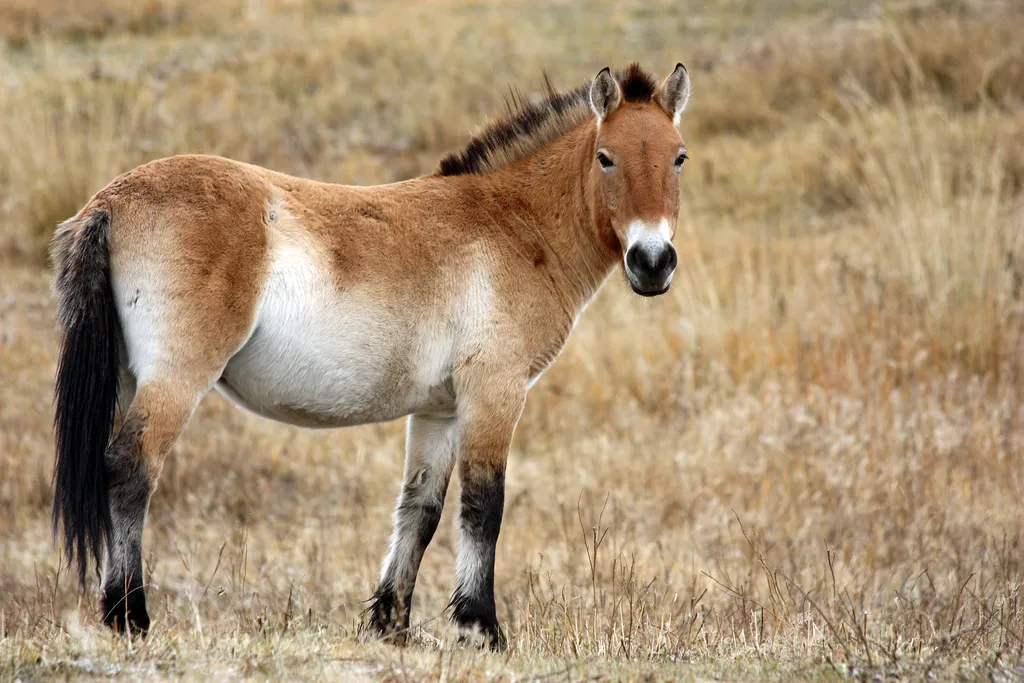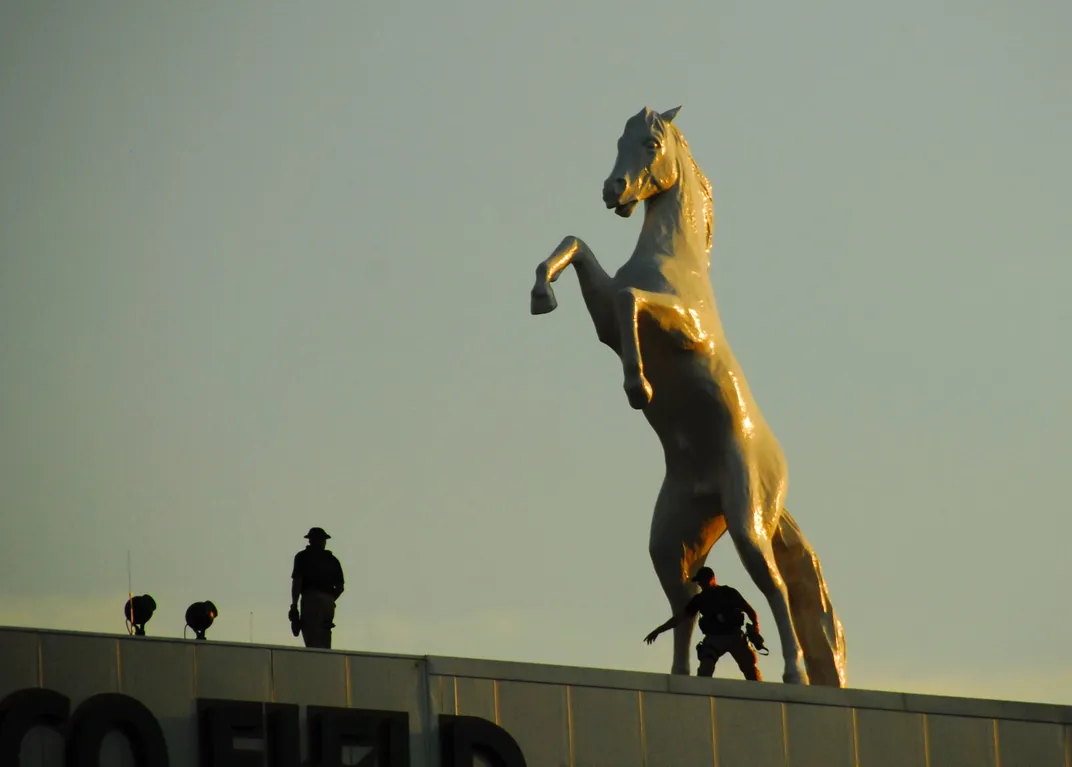14 Fun Facts About Broncos
Number six: Horses once had three toes
/https://tf-cmsv2-smithsonianmag-media.s3.amazonaws.com/filer/bd/67/bd67a9bd-4d9c-4270-810e-e28fec163dd2/5656445995_74bba638ae_b.jpg)
Movies and novels might lend the impression that horses have a docile and friendly nature, but in the animal world, a bronco is a formidable opponent. Weighing in at 900 pounds, the Denver Broncos mascot, Thunder, is an Arabian gelding—a breed with a lot of history and a reputation for high endurance. (Sort of like Peyton Manning, you might say.)
Whether you're a rabid football fan or you just watch for the commercials, we're here to help you drop some knowledge on your friends over the queso dip between plays. Here's 14 facts about broncos, and be sure to check out our 14 facts about sea hawks too.
1. Broncos don't exist, at least in scientific terms.
No, it's not because the bronco went extinct in 1996. (That's the car; we're talking about the animal here.) A bronco is a type of horse, not a species or a breed. It comes from the Spanish broncos, which means rough. American cowboys borrowed the lingo from their Mexican counterparts to describe untrained or partially trained horses. Originally, cowboys probably used the term to refer to breaking wild horses, but today's broncos are not feral.
2. Broncos were featured in the first rodeos.
Riding broncs was listed as an event in the program of Buffalo Bill Cody's Wild West Show's first rodeo in North Platte, Nebraska, in 1882. Though the rodeo gained huge popularity, bronc riding is one event that has frequently garnered controversy, due to animal treatment and training methods. Cowboys ride broncs in two ways, with a saddle and without, and riding bareback is considered the more difficult of the two.
3. Bucking is natural.
Horses buck for a variety of reasons—fright, surprise, or provocation. It's a natural behavior, and some believed it developed in response to attacks from feline predators. Particularly spirited horses prone to bucking are sold and trained for the rodeo (though not nearly for the wages that football players are paid these days).
4. Broncos may be rough, but they're not wild.
Genetically speaking, there’s only one truly wild horse. That’s Przewalski’s horse (Equus ferus przewalskii). Until a few years ago, this species was extinct in its native Mongolia, but thanks to breeding programs in captivity, it's been revived. So-called wild horse communities in the U.S. are actually descended from domesticated horses that went feral.

5. Modern horses are four million years old.
Humans didn't domesticate the horse until about 4000 years ago, but the species has been around for a very long time. Though hundreds of breeds exist, all domesticated horses come from the same species: Equus ferus. Based on evidence from a 700,000-year-old horse fossil and other specimens, scientists believe that horses split off from donkeys and zebras around four million years ago, and the oldest known ancestor in this lineage lived about 55 milions years ago.
6. Horses once had three toes.
Hyrathocotherium, an ancient horse relative that lived about 50 million years ago, had three padded toes, perhaps more similar to the paws of a dog than the hooves of modern horses. Scientists hypothesize that as horses gained speed, they lost toes, producing the single hardened hoof we see today.
7. Global warming once shrank the horse.
During a 5 to 10°C bump in global temperatures around 130,000 years ago, ancient horses' body mass shrunk by about 30 percent—perhaps because under warmer conditions, less energy is needed to keep a smaller body cool, or maybe due to an impact of carbon dioxide on food availability. Then, when the climate cooled back down, they grew by about 76 percent, eventually reaching their current size.

8. Arabian horses are hot bloods.
The Denver Broncos' mascot, Thunder, is an Arabian gelding. One of three breed classifications, hot bloods are known for their speed and endurance. (For comparison, cold bloods are slow and calm, and warm bloods were bred to be sort of a mix of the two.) Arabian horses have given rise to more breeds than any other group, and they have an illustrious pedigree of riders, from Alexander the Great to George Washington.
9. Horses are social butterflies.
As herd animals, horses rely on relationships with other animals. They can even tell other horses apart based on their whinnies. Friendships with other horses are beneficial to their health: Female horses with friends are more likely to give birth to more offspring and those offspring are more likely to survive. There's also anecdotal evidence to suggest that horses retain memories of bad experiences with humans, and a March 2010 study suggested that horses can form positive memories of humans as well.
10. Horses don’t get stage fright.
While many things might spook a horse, stage fright doesn’t. In a study published in The Veterinary Journal, scientists measured stress hormones and heart rates in horses compared to their professional riders. Horses’ stress levels didn’t change whether they were in front of a crowd or just practicing.
11. Horses sleep both sitting down and standing up.
Horses have a stay mechanism in their legs that allows them to snooze standing up, an adaptation that allows them to more quickly react and run away from a potential predator. To reach REM sleep, they need to lie down, though, and they usually do that for about three hours throughout the day. In herds, horses often sleep according to the buddy system: some lie down while others stand up to keep watch.
12. Horses can get a sugar high.
Eating sweet snacks, such as sugar cubes, molasses, barley and corn can make a horse's coat shinier and gives them a burst of energy. But in young horses, too much sugar can also cause them to act out and misbehave. Sound familiar?
13. Some horses can walk, trot, gallop, and pace thanks to a single mutation in their genome.
Horses traditionally have three gaits: walking, trotting, and galloping. But select breeds can do what are called "unusual gaits." The American Standardbred and some Icelandic breeds can pace, moving the legs on each side of their body in unison. Those breeds have a mutation in a gene called DMRT3 that gives them this ability.
14. To figure out whether a horse is right or left hooved, just look at its hair.
If you look at a horse's head, you'll notice that the hair on their forehead grows in a circular curl. Scientists have found that out of 108 horses that favor their left hoof, 75 percent had hair growing counter clockwise. They see the opposite trend in right hooved horses: Their hair tends to grow clockwise. For racehorses, the tendency to favor right or left hooves is of strategic importance.
/https://tf-cmsv2-smithsonianmag-media.s3.amazonaws.com/accounts/headshot/Screen_Shot_2014-01-27_at_12.05.16_PM.png)
/https://tf-cmsv2-smithsonianmag-media.s3.amazonaws.com/accounts/headshot/Screen_Shot_2014-01-27_at_12.05.16_PM.png)